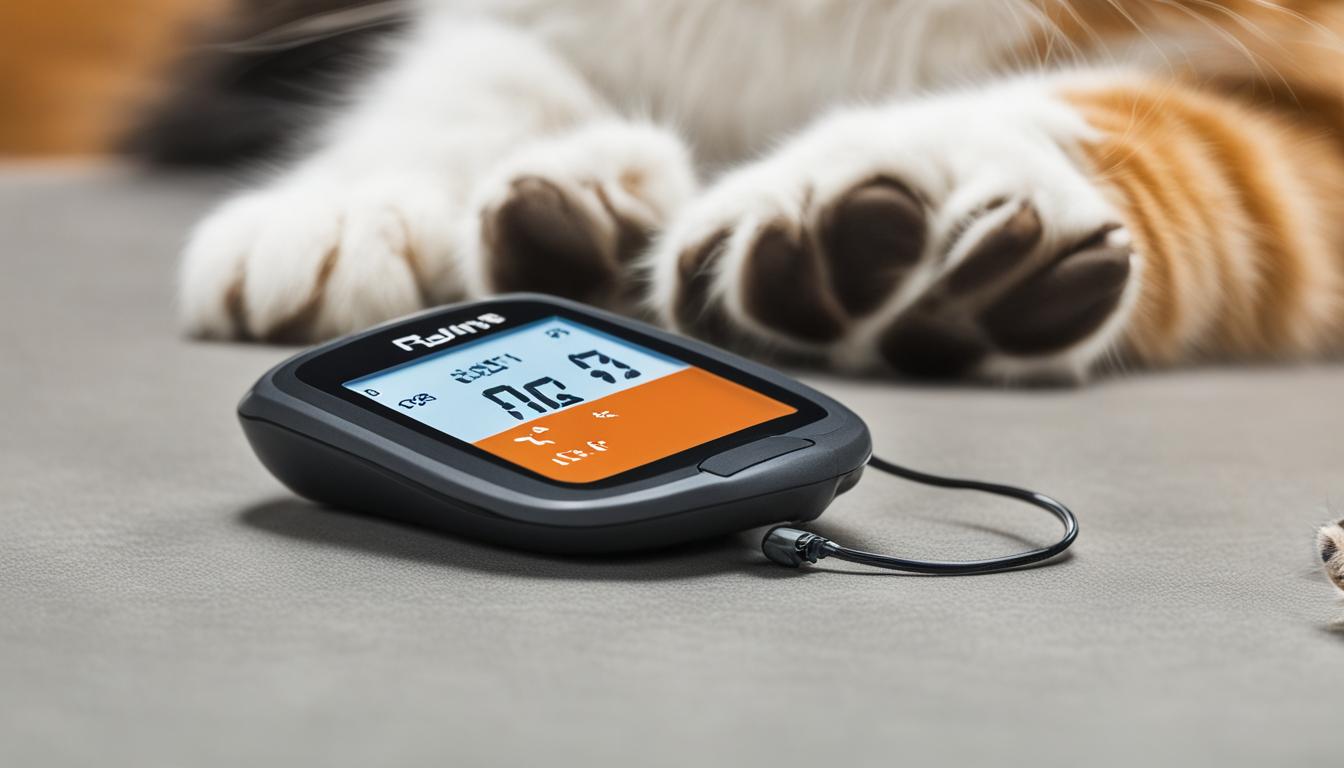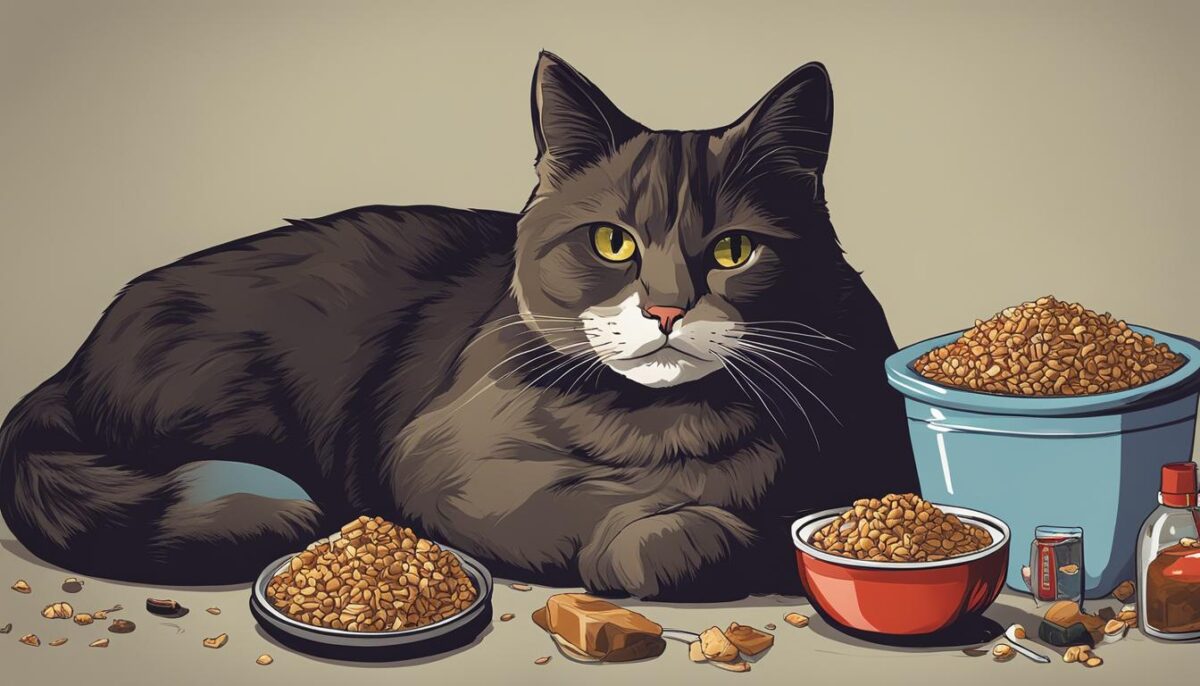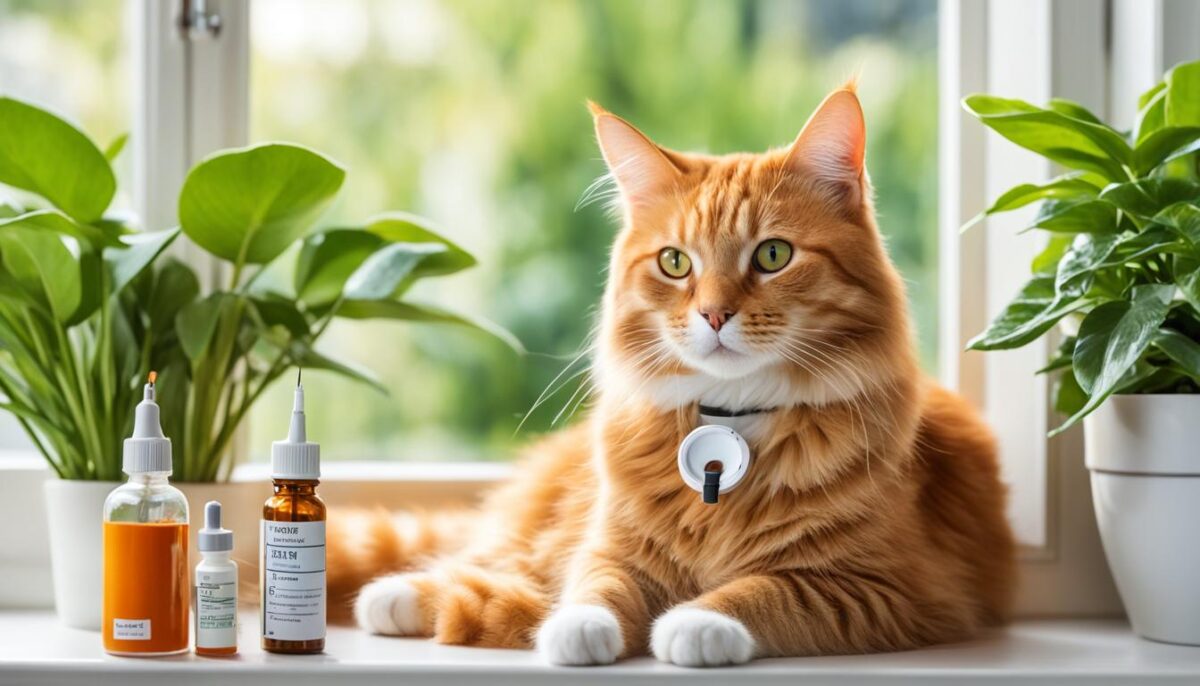If you have a furry friend at home, knowing about feline diabetes is important. Just like people, cats can get diabetes, too. It means they have trouble turning sugar in their blood into energy. It happens when something’s not right with a thing called insulin. Some cats don’t make enough of it, and some just can’t use it right. Don’t worry, though. You can learn all about cat diabetes symptoms and how to manage feline diabetes.
Did you know that between a small number of cats can have diabetes? It doesn’t happen a lot, but it’s something to keep an eye on for your cat’s health. To keep your cat happy, it’s good to know what to look for and how to help them.
Key Takeaways
- Cats can have diabetes just like humans.
- Knowing the signs of diabetes can help you take care of your cat.
- Insulin is super important for a cat’s body to use sugar.
- Type I and Type II diabetes affect cats in different ways.
- Helping your cat stay fit can lower their risk of getting diabetes.
- With the right care, cats with diabetes can still be happy and playful.
Understanding Feline Diabetes
Diabetes can happen to cats just like it can happen to people. Imagine if your body had a hard time using sugar the right way because it needed a special helper called insulin. Well, that’s what happens with diabetes mellitus in cats. It’s important to learn about this so we can help our furry friends stay healthy.
What is Diabetes Mellitus in Cats?
When cats have diabetes mellitus, it means there’s too much sugar floating around in their blood. That’s because they’re having trouble with insulin. Insulin is like a key that lets sugar into cells so they can use it for energy.
How Insulin Functions in a Cat’s Body
Insulin in cats works like a tiny security guard that tells the cells to open up and let the sugar in. When a cat doesn’t have enough insulin, sugar can’t get into the cells, and instead, it stays in the blood. That’s not good because the body needs sugar in cells to have energy.
Type I vs. Type II Diabetes in Felines
There are two different types of diabetes that can affect cats. Type I feline diabetes happens when a cat’s body doesn’t make enough insulin at all. Type II feline diabetes is a bit different because the body does make insulin, but it doesn’t work right. The cells don’t respond well to the insulin, and the sugar can’t get into the cells like it should. Most cats with diabetes have Type II.
| Type of Diabetes | Body Makes Insulin? | Cells Respond to Insulin? |
|---|---|---|
| Type I Diabetes | No, not enough | Not applicable |
| Type II Diabetes | Yes, normally | No, they resist it |
Learning about this helps us understand why our sweet kitties might need extra care. If we know how to spot the signs and give them the right help, they can still live happy, purr-filled lives!
Risk Factors and Symptoms of Feline Diabetes
Hey there! Did you know that some cats can get diabetes just like people? Yes, they can, and there are certain things that can make it more likely for them to get sick. It’s good for you to know about these things so you can help keep your furry friend healthy and happy.
Key Factors That Increase Diabetes Risk in Cats
Some cats have a greater chance of getting diabetes. If a kitty is kind of heavy or doesn’t play and run around much, it can put them at risk. Older cats and male cats also have higher chances of being diabetic. Let’s not forget, certain breeds can be more likely to get diabetes too. However, you can do lots to help! Keeping cats slim and active can really make a difference.
Common Signs That May Indicate Your Cat Has Diabetes
You might be wondering how you’d know if your cat has diabetes. There are signs to look out for! If your fluffy buddy is eating a lot but still losing weight, or if they’re drinking way more water and going to the litter box a lot, it might be time to visit the vet. These could be symptoms of diabetes in cats. Keep an eye on your pet for these changes, especially if they are one of the diabetic cats at higher risk.
| Risk Factors | Signs to Watch For |
|---|---|
| Overweight | Drinking more water than usual |
| Lack of exercise | Going to the litter box more often |
| Old age | Losing weight even though eating well |
| Specific breeds | Lethargy or not playing as much |
| Male cats | Coat becomes dull or unkempt |
Remember, if you see any of these signs or if you’re worried about risk factors for feline diabetes in your cat, a vet visit is a good idea. The sooner you find out, the sooner you can help your cat feel better!
Diagnostic Procedures & Management
When your pet friend might be feeling under the weather, it’s important to find out what’s going on. Diagnosing cat diabetes is a crucial step to make your fluffy companion better. Vets do this by checking the feline glucose levels in their blood and pee. One simple test can tell a lot about your cat’s health.
But what if those levels are high? Your vet might think your cat has diabetes. Sometimes, they need to do more tests to be sure because other sicknesses can act like diabetes too.
Once they know for sure, it’s all about diabetes management in cats. Good care usually includes special food and insulin shots to help control the sugar in their blood. This makes your cat feel much better!
Some cats may need those insulin shots just once a day, but others might need two. Here’s a handy table to show what that diabetes testing in cats and care might involve:
| Checkup | Why It’s Done | How Often |
|---|---|---|
| Blood Sugar Test | To measure glucose in blood | At vet visits |
| Urine Test | To spot sugar in pee | At vet visits |
| At-Home Monitoring | To keep an eye on health daily | Every day |
| Insulin Shots | To help with glucose levels | 1 or 2 times a day |
Remember, it’s super important to check in with your vet and give your cat the right food and medicine. With your help, your cat can still purr and play even with diabetes.
Conclusion
The journey through understanding feline diabetes does not end just with diagnosis. While it’s true that this health issue can’t be completely fixed, your cat can still have a joyful and comfortable life with your support and proper care. Managing feline diabetes really comes down to keeping an eye on your cat’s health and working closely with your vet. This is key to giving your cat the best chance at a good life.
Keeping track of your cat’s health might sound like a big task, but it’s all about regular vet visits and watching for any changes at home. Early treatment can sometimes lead to what is known as cat diabetes remission, which means the signs of diabetes can go away. That’s a big win for you and your cat!
Remember, a positive feline diabetes prognosis often hinges on how well the condition is handled day-to-day. By making sure your furry friend gets the care they need, you are helping them live their nine lives to the fullest. So stay alert, and always keep love and good care in your kit of tools to support your cat’s health and happiness.
FAQ
Can cats develop diabetes?
Yes, cats can develop diabetes. This condition means they have difficulty processing sugar in their blood due to insulin issues, much like in humans.
What is diabetes mellitus in cats?
Diabetes mellitus in cats is a condition where there’s an excessive amount of sugar in the blood because the cat’s body has problems with insulin, a hormone essential for sugar regulation.
How does insulin function in a cat’s body?
Insulin acts like a key, opening the doors of cells in the body to allow sugar to enter and be used for energy.
What’s the difference between Type I and Type II diabetes in felines?
Type I diabetes in felines occurs when the cat’s body does not produce enough insulin. Type II, which is more common in cats, occurs when the body produces insulin but does not respond properly to it.
What are the key factors that increase diabetes risk in cats?
Overweight, lack of physical activity, age, gender (males are more susceptible), and genetics are key factors that can increase the risk of a cat developing diabetes.
What are common signs that may indicate a cat has diabetes?
A cat with diabetes might lose weight despite having a good appetite, and may drink and urinate more than usual. These are some of the common symptoms of diabetes in cats.
How do vets diagnose diabetes in cats?
Vets will check the levels of glucose in a cat’s blood and urine. Sometimes they conduct additional tests to rule out other illnesses that could mimic the symptoms of diabetes.
How is diabetes managed in cats?
Managing diabetes in cats often involves a special diet and insulin injections, which some cats may need once or twice a day.
Can feline diabetes be cured?
While there is no cure for diabetes in cats, many can live a happy life with proper management. Some cats may even go into remission and no longer show symptoms of the disease with early and effective treatment.
What should I monitor if my cat has diabetes?
Regular vet checks and monitoring your cat’s diet, weight, insulin levels, and behavior at home are all crucial for keeping a diabetic cat healthy and avoiding complications from the disease.
Source Links
- https://www.vet.cornell.edu/departments-centers-and-institutes/cornell-feline-health-center/health-information/feline-health-topics/feline-diabetes
- https://vcahospitals.com/know-your-pet/diabetes-mellitus-in-cats-overview
- https://vcahospitals.com/know-your-pet/diabetes-in-cats-testing-and-monitoring


